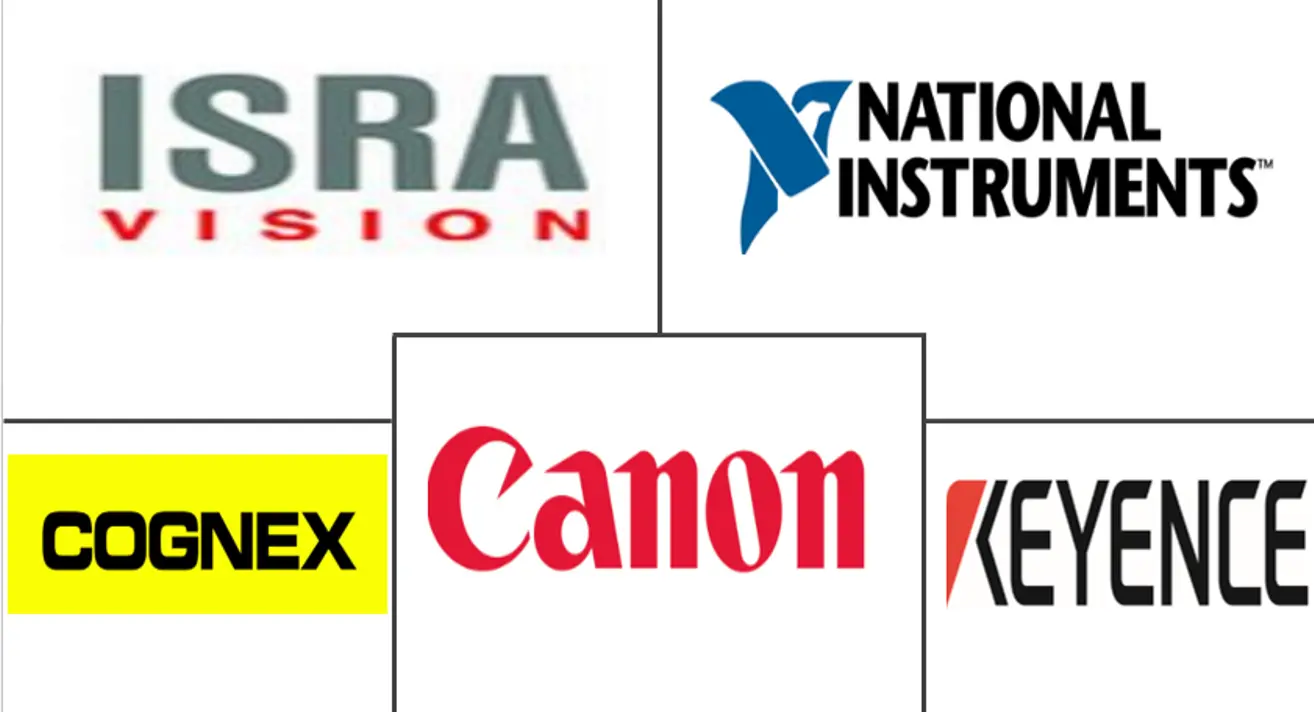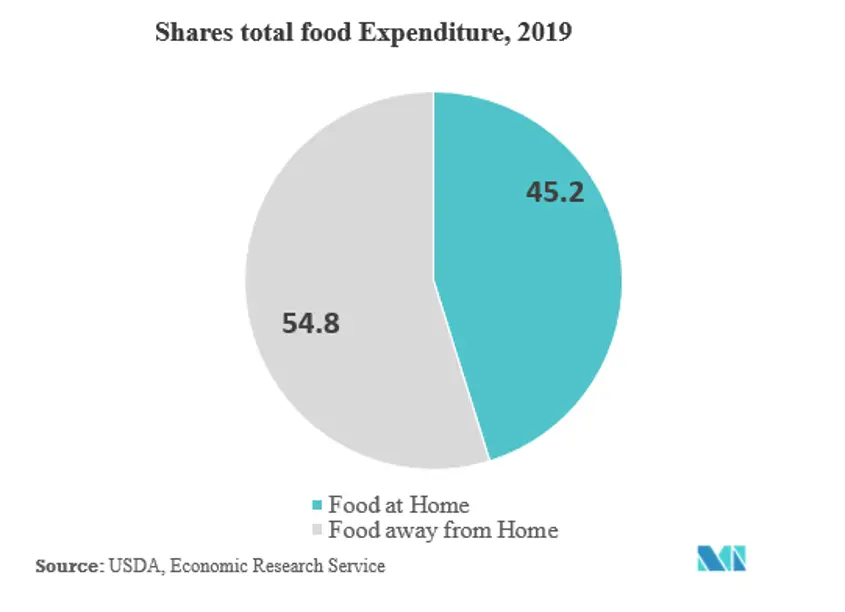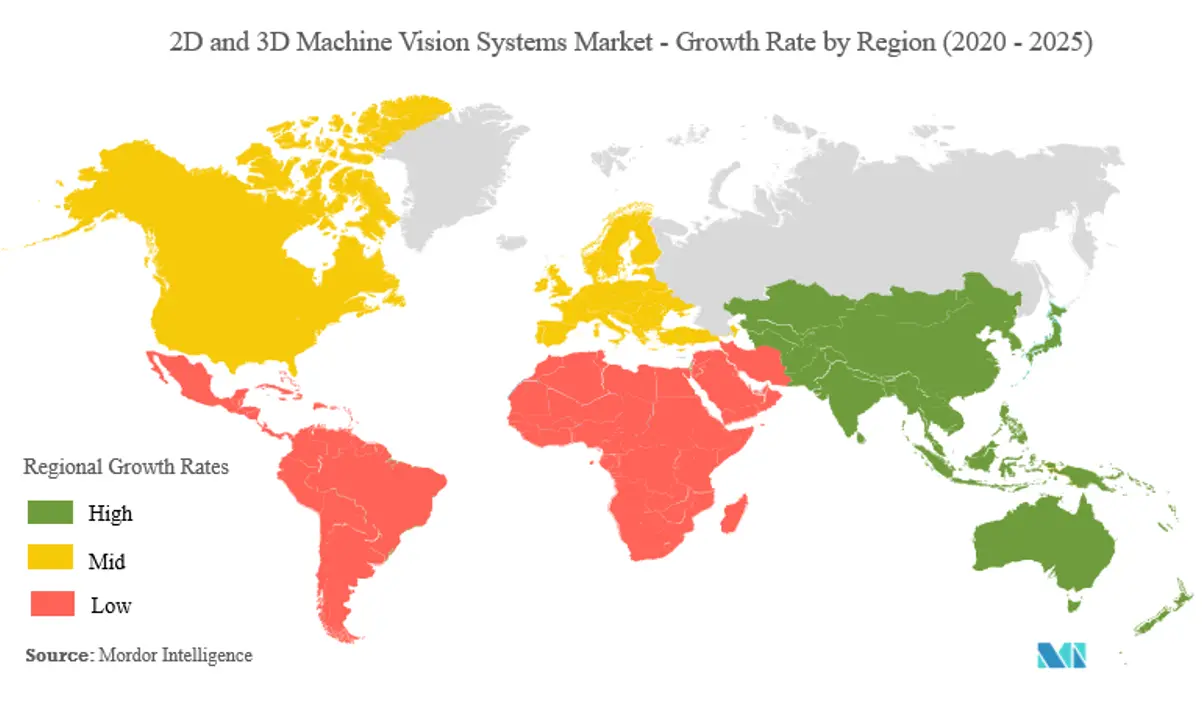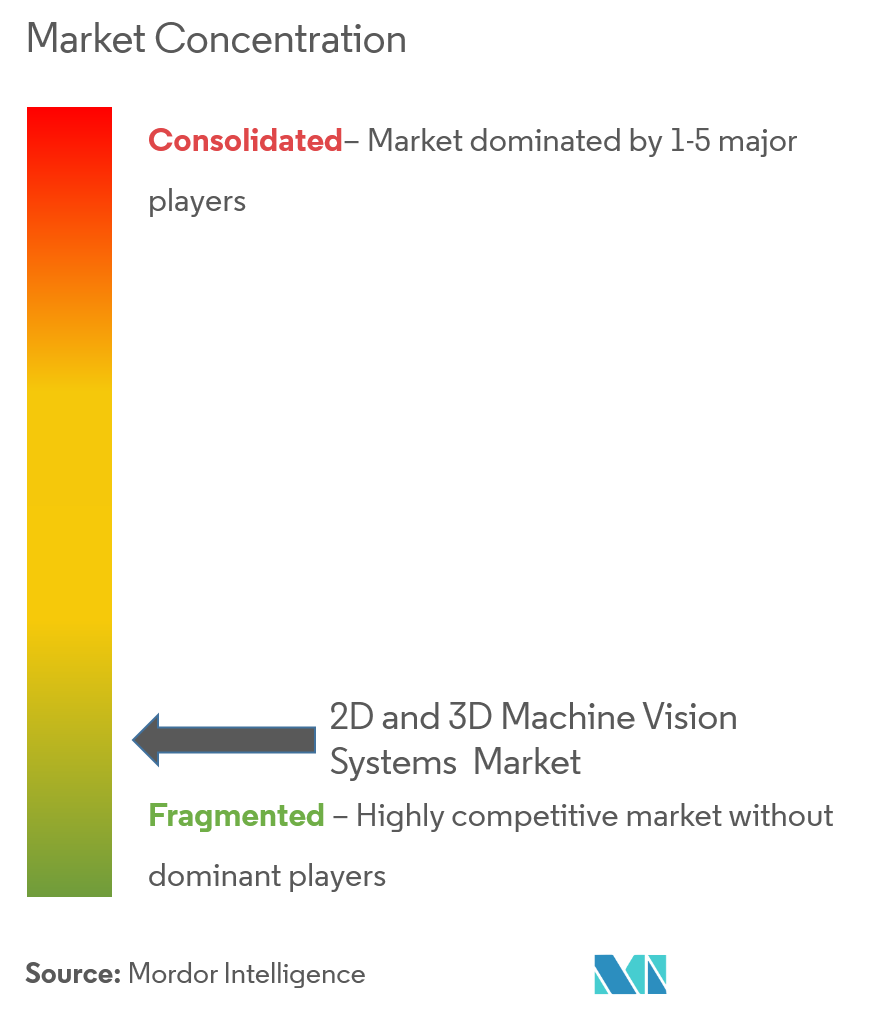2D and 3D Machine Vision Systems Market Size

| Study Period | 2019 - 2029 |
| Base Year For Estimation | 2023 |
| CAGR | 13.32 % |
| Fastest Growing Market | Asia Pacific |
| Largest Market | Europe |
| Market Concentration | Low |
Major Players
*Disclaimer: Major Players sorted in no particular order |
2D and 3D Machine Vision Systems Market Analysis
The 2D and 3D machine vision systems market was valued at USD 11.14 billion in 2020 and is expected to reach USD 23.5 billion by 2026, at a CAGR of 13.32% forecast period 2021 to 2026. According to the Automated Imaging Association, machine vision includes all industrial and non-industrial applications in which a combination of hardware and software components provide operational guidance to devices in the execution of their functions based on the capture and processing of images.
- Machine vision provides machines with a gift of sight, complementing or replacing manual inspection tasks, using cameras and image processing. Machine vision applications range from basic tasks, like presence detection, to real-time inspection and grading tasks in harsh environments.
- Manufacturing firms worldwide realize the benefits of machine vision systems, particularly in areas where redundant tasks, like inspection, should be performed with precision. They are playing an essential role in high-speed production lines and hazardous environments. Some of the significant benefits offered by these systems include increased productivity, reduced machine downtime, and tighter process control.
- Over the year, 2D machine vision system has gained a significant application across the industry, in which the target object image acquired for processing is effectively a flat, 2D plan view. This 2D image does not provide any height information. When utilizing 2D cameras, Z (distance from the camera) is generally assumed. This is not as effective as parts may move, change the size, etc., and then the 2D camera may miscalculate the location. For such reasons, end-user industries embrace 3D systems, which allows for a clean part pick-up with known positional data (X, Y, and Z), despite any disruption.
- Recently, in collaboration with Samsung, researchers from the Harvard John A. Paulson School of Engineering and Applied Sciences (SEAS) programmed the first 2D neural network using materials that are only a few nanometers thick (or less). The materials, often made up of a single sheet of atoms, made it possible for the machine vision processor to capture, store, and recognize more than 1,000 images.
- Organizations across the globe are taking in-depth looks at how Industry 4.0 technologies could help them return to productive operations during the COVID-19 crisis. A survey from Plex Systems, a company that sells an intelligent manufacturing platform, surveyed global businesses to learn about their progress in using Industry 4.0 applications. The results showed that only 24% of respondents adopted smart manufacturing options. However, 22% launched pilots to assess the technological solution's worthiness.
2D and 3D Machine Vision Systems Market Trends
This section covers the major market trends shaping the 2D & 3D Machine Vision Systems Market according to our research experts:
Food and Beverages is Expected to Register a Significant Growth
- The food and beverage sector is one of the most significant markets for machine vision systems owing to growing safety culture and stringent government regulations forcing companies to adopt advance inspection procedures as a part of automation.
- The uniform and systematic application of machine vision in the food industry over the past decade is mainly attributed to continual developments in constituent methodologies, such as image processing and pattern recognition. Moreover, technological advancements have permitted feasible implementation of these machines at lower cost.
- Inspection of food (concerned predominantly with defects or contaminants), quality control, and in some cases, assembly control of more complex foods (pizzas and layer cakes) during the processing of food are some of the major areas of scope where the machine vision systems find applications.
- For instance, chocolate inspection is one such application where machine vision is utilized to control the amount of chocolate that reaches the product. Any change in the amount of chocolate may either increase the cost of the product or break the layer of chocolate, leading to product failure or consumer dissatisfaction.
- The rapid development in the computer technology and improved expectations of the customers and regulatory bodies have boosted the demand for food quality and safety, resulting in the increasing adoption of automated systems in the food industry.

North America is Expected to Hold a Significant Share in the Market
- North America is a substantial market for vendors offering solutions for machine vision. The regional market is expected to grow significantly over the forecast period, owing to the early adoption of automation in the manufacturing and healthcare industries.
- In North America, the sales of machine vision components and systems that provide vision intelligence to robots and other machines increased significantly in 2018, according to AIA, the industry trade group, and part of the Association for Advancing Automation (A3).
- In July 2019, Microchip Technology Corporation introduced its Smart Embedded Vision Initiative. The new ecosystem utilizes Microchip’s low-power PolarFireFPGAs with a series of high-speed imaging interfaces, intellectual property for image processing, and an enhanced ecosystem of outside partnerships. This initiative is designed to bolster machine vision advances for applications such as industrial, medical devices, automotive, and aerospace.
- In November 2019, First Sensor AG collaborated with a Canadian expert to produce image sensors for industrial visual inspection in the field of machine vision. The project has a duration of seven years.
- Beckhoff Automation introduced new TwinCAT Vision software at the US Pack Expo 2019. It adds a comprehensive image processing feature into the range of machine control programming and runtime in TwinCAT 3 (a software system with real-time control). It also enables users to harness the benefits of GigE Cameras on diverse machines and lines without requirements for separate, third-party vision systems.
- Such innovations by vendors, both in terms of hardware and software, are expected to amplify the market demand over the forecast period.

2D and 3D Machine Vision Systems Industry Overview
The 2D and 3D machine vision systems market is highly fragmented in nature. Due to the presence of several players, the market has strong competition. The major players in the market are Cognex Corporation, ISRA Vision AG, Keyence Corporation, National Instruments, XIMEA GmbH, Omron Corporation, IDS Imaging Development Systems Gmbh, Canon USA Inc., A&B Software, Datalogic S.p.A, Epic Systems Inc., Sick AG, among others.
- April 2020 - Cognex Corporation introduced the In-Sight D900 embedded vision system. A first-of-its kind solution, the In-Sight D900 features Cognex's ViDideep learning software inside an In-Sight industrial-grade smart camera. The self-contained system is designed to solve a broad range of complex in-line inspection applications including optical character recognition (OCR), assembly verification, and defect detection.
- August 2019 - IDS planned to expand its USB3 vision camera range by more than 100 models. This means it will integrate the entire range of sony sensors which are already available with GigE Vision. The new cameras can be used with IDS peak, IDS brand-new, hardware-independent SDK.
2D and 3D Machine Vision Systems Market Leaders
-
Cognex Corporation
-
ISRA Vision AG
-
Keyence Corporation
-
National Instruments
-
Canon USA Inc.
*Disclaimer: Major Players sorted in no particular order

2D and 3D Machine Vision Systems Market Report - Table of Contents
1. INTRODUCTION
- 1.1 Study Assumptions and Market Definition
- 1.2 Scope of the Study
2. RESEARCH METHODOLOGY
3. EXECUTIVE SUMMARY
4. MARKET DYNAMICS
- 4.1 Market Overview
-
4.2 Market Drivers
- 4.2.1 Increasing Need for Quality inspection and Automation
- 4.2.2 Growing Application of the Internet of Things in the Industrial Sector
-
4.3 Market Restraints
- 4.3.1 Lack of Efficient System Operators due to Inadequate Training to Hamper the Growth
-
4.4 Industry Attractiveness - Porter's Five Force Analysis
- 4.4.1 Threat of New Entrants
- 4.4.2 Bargaining Power of Buyers/Consumers
- 4.4.3 Bargaining Power of Suppliers
- 4.4.4 Threat of Substitute Products
- 4.4.5 Intensity of Competitive Rivalry
- 4.5 Industry Value Chain Analysis
- 4.6 Assessment of Impact of Covid-19 on the Market
5. MARKET SEGMENTATION
-
5.1 Component
- 5.1.1 Hardware
- 5.1.1.1 Vision Systems
- 5.1.1.2 Cameras
- 5.1.1.3 Optics and Illumination Systems
- 5.1.1.4 Frame Grabber
- 5.1.1.5 Other Types of Hardware
- 5.1.2 Software
-
5.2 Product
- 5.2.1 PC-based
- 5.2.2 Smart Camera-based
-
5.3 End user Industry
- 5.3.1 Food and Beverage
- 5.3.2 Medical Devices
- 5.3.3 Pharmaceutical
- 5.3.4 Automotive
- 5.3.5 Electronics and Semiconductors
- 5.3.6 Other End user Industries
-
5.4 Geography
- 5.4.1 North America
- 5.4.2 Europe
- 5.4.3 Asia Pacific
- 5.4.4 Rest of the World
6. COMPETITIVE LANDSCAPE
-
6.1 Company Profiles*
- 6.1.1 Cognex Corporation
- 6.1.2 Keyence Corporation
- 6.1.3 Omron Corporation
- 6.1.4 ISRA Vision AG
- 6.1.5 IDS Imaging Development Systems GmbH
- 6.1.6 National Instruments Corporation
- 6.1.7 MVTec Software GmbH
- 6.1.8 Sony Corporation
- 6.1.9 Teledyne DALSA
- 6.1.10 Toshiba Corporation
- 6.1.11 Canon USA Inc.
- 6.1.12 Sick AG
- 6.1.13 Datalogic S.p.A
- 6.1.14 Baumer Optronic GmbH
- 6.1.15 Adimec Advanced Image Systems B.V.
- 6.1.16 Allied Vision Technologies GmbH
7. INVESTMENT ANALYSIS
8. FUTURE OF THE MARKET
** Subject To Availablity2D and 3D Machine Vision Systems Industry Segmentation
A 2D and 3D machine vision system is the substitution of the human visual sense and judgment capabilities with a video camera and computer to perform an inspection task. It is the automatic acquisition and analysis of images to obtain desired data for controlling or evaluating a specific part or activity. According to the Automated Imaging Association, machine vision includes all industrial and non-industrial applications in which a combination of software and hardware provides operational guidance to devices in the execution of their functions based on the capture and processing of images. Under component, hardware and software are considered under the scope. The hardware includes vision systems, cameras, optics and illumination systems, frame grabber, and other types of hardware. Under component, hardware and software are considered under the scope. The hardware includes vision systems, cameras, optics and illumination systems, frame grabber, and other types of hardware.
| Component | Hardware | Vision Systems |
| Cameras | ||
| Optics and Illumination Systems | ||
| Frame Grabber | ||
| Other Types of Hardware | ||
| Component | Software | |
| Product | PC-based | |
| Smart Camera-based | ||
| End user Industry | Food and Beverage | |
| Medical Devices | ||
| Pharmaceutical | ||
| Automotive | ||
| Electronics and Semiconductors | ||
| Other End user Industries | ||
| Geography | North America | |
| Europe | ||
| Asia Pacific | ||
| Rest of the World |
2D and 3D Machine Vision Systems Market Research FAQs
What is the current 2D and 3D Machine Vision Systems Market size?
The 2D and 3D Machine Vision Systems Market is projected to register a CAGR of 13.32% during the forecast period (2024-2029)
Who are the key players in 2D and 3D Machine Vision Systems Market?
Cognex Corporation, ISRA Vision AG, Keyence Corporation, National Instruments and Canon USA Inc. are the major companies operating in the 2D and 3D Machine Vision Systems Market.
Which is the fastest growing region in 2D and 3D Machine Vision Systems Market?
Asia Pacific is estimated to grow at the highest CAGR over the forecast period (2024-2029).
Which region has the biggest share in 2D and 3D Machine Vision Systems Market?
In 2024, the Europe accounts for the largest market share in 2D and 3D Machine Vision Systems Market.
What years does this 2D and 3D Machine Vision Systems Market cover?
The report covers the 2D and 3D Machine Vision Systems Market historical market size for years: 2019, 2020, 2021, 2022 and 2023. The report also forecasts the 2D and 3D Machine Vision Systems Market size for years: 2024, 2025, 2026, 2027, 2028 and 2029.
2D and 3D Machine Vision Systems Industry Report
Statistics for the 2024 2D and 3D Machine Vision Systems market share, size and revenue growth rate, created by Mordor Intelligence™ Industry Reports. 2D and 3D Machine Vision Systems analysis includes a market forecast outlook 2029 and historical overview. Get a sample of this industry analysis as a free report PDF download.



